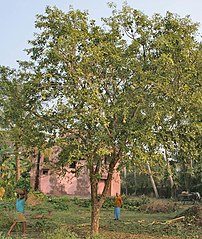[amazon_link asins=’B01MRZNKR6,B01N7K1YLE,B01N1UCUP9,B06WVLLS77,B01NBNUGTF,B01N5NAXCP,B01NAUI8AY,B06X6DK96R,B01N4X02BR’ template=’ProductCarousel’ store=’finmeacur-20′ marketplace=’US’ link_id=’ba1313dd-2b06-11e7-a51f-e35ab8abe04f’]
Botanical Name : Albizia lebbek
Family: Fabaceae
Genus: Albizia
Species:A. lebbeck
Kingdom:Plantae
Order: Fabales
Synonyms:Mimosajebbeck L; M.sinssa Roxb;
Local Names:Siris;acacia amarilla; East Indian Wal nut
Vernacular Names: Sans, Hind: Sirish. Eng : East Indian walnut.
English names: lebbeck, lebbek tree, flea tree, frywood, koko and woman’s tongues tree
BENGALI NAME:SIRISH
Habitat: According to the NAS (1980) this is native to tropical Africa, Asia, and northern Australia, widely planted and naturalized throughout the tropics.
Description
Albizia lebbek is a deciduous tree to 30 m tall, with a dense shade-producing crown. Bark smoothish, light whitish or greenish gray. Leaves alternate, twice compound, with 2–4 pairs of pinnate pinnae, each with 4–10 pairs of leaflets, the ultimate leaflets entire, arcuate, oblong. Flowers white, with greenish stamens, in clusters resembling a white powder puff. Pods flat, reddish brown, several seeds, often rattling in the breeze. In Puerto Rico, flowers April to September, fruiting year-round, the fruits more prominent probably in the dry season.
CLICK & SEE
Cultivation
Immerse seed in boiling water, cool; soak for 24 hours, sowing in loam in wrapped pots 10 x 15 mm. Move seedlings to partial shade, watering and spraying as needed. Harden off for 2–3 months. Outplant at 3 x 3 or 4 x 4 m when at least 30 cm tall, at beginning of rainy season (Fabian, 1981).
Chemical Constituents: According to Roskoski et al (1980), studying Mexican material, the seeds contain 9.47% humidity, 3.57% ash, 33.60% crude protein, 3.13% crude fat, 13.17% crude fiber, 35.30% carbohydrates with a 78.25% in vitro digestibility. The pods contain 6.99% humidity, 5.47% ash, 17.86% crude protein, 2.6% crude fat, 45.08% crude fiber, and 22.00% carbohydrates with a 76.56% in vitro digestibility. The foliage contains 3.57% humidity, 7.06% ash, 28.87% crtide protein, 5.42% crude fat, 31.75% crude fiber, 23.33% carbohydrates, and 83.55% in vitro digestibility. Prohibitive levels of toxic compounds were not detected in any of the plant parts analyzed.
Uses
A fast growings nitrogen-fixing, heavy shade tree, recommended for reforestation and firewood plantations. Often planted as an avenue tree or as shade for coffee and tea. The wood is hard and strong, resembling walnut, and non siliceous. It produces a sawdust that may cause sneezing. Specific gravity 0.61; Air Dry Weight 39 lb/cu ft (ca 630 kg/cu m). The heartwood calorific value is 5,166 cals. Strong and elastic, the wood is used for cabinet wood, furniture and veneer, and serves well as firewood. The burr wood is prized for veneer. Bark has served for tanning. Foliage can be used as fodder. In the Sudan, goats eat fallen leaves and flowers. Bark containing saponin can be used in making soap, and containing tannin, can be used for tanning; used e.g. in Madras to tan fishing nets. It produces a gum which can be sold deceitfully as gum arabic. Host of the lac insect.
Its uses include environmental management, forage, medicine and wood. In India and Pakistan, the tree is used to produce timber. Wood from Albizia lebbeck has a density of 0.55-0.66 g/cm3 or higher.
Even where it is not native, some indigenous herbivores are liable to utilize lebbeck as a food resource. For example, the greater rhea (Rhea americana) has been observed feeding on it in the cerrado of Brazil.
Folk Medicine
According to Hartwell (1967–1971), the tree is used in folk remedies for abdominal tumors, in bolmes, enemas, ghees or powders. Reported to be astringent, pectoral, rejuvenant, and tonic, the siris tree is a folk remedy for boils, cough, eye ailments, flu, and lung ailments. The seed oil is used for leprosy, the powdered seed to scrofulous swellings. Indians use the flowers for spermatorrhea.
As per Ayurveda:
The plant is katu, sheela (sheelaveerya), beneficial in poisoning, derangedvata, scabies, dyscrasia, leprosy, pruritus and other skin diseases. Said to strengthen gums ,applied externally as plaster in leprous ulcers.
Parts used : seeds, leaves, bark
Therapeutic uses: seeds and bark are astringent, tonic, leaves are remedy for night blindness,
The root is used in hemicrania.-
The bark is bitter; cooling, alexiteric, anthelmintic; cures” vata “, diseases of the blood, leucoderma, itching, skin diseases, piles, excessive perspiration, inflammation, erysepelas, bronchitis; good in rat-bite.-
The flowers are given for asthma,
The root is astringent and prescribed for ophthalmia.-
The bark is anthelmintic; relieves toothache, strengthens the gums and the teeth; used in leprosy, deafness, boils, scabies, syphilis, paralysis, weakness.-
The leaves are useful in ophthalmia The leaves are good in night; blindness.-
The flowers are aphrodisiac, emollient, maturant: their smell is useful in hemicrania. The flowers are used as a cooling medicine, and also externally applied in boils, eruptions and swellings
The seeds are aphrodisiac, tonic to the brain; used for gonorrhoea, and tuberculous glands; the oil is applied topically in leucoderma.
The bark and seeds are astringent, given in piles, diarrhoea, etc.
The bark is applied to injuries to the eye..
The seeds form part of an anjan used for ophthalmic diseases.The oil extracted from them is ,considered useful in leprosy.
The powder of root- bark is used to strengthen the gums when they are spongy and ulcerative.
The seeds are considered astringent used in diarrhea, dysentery, piles. The flowers are emollient and applied to boils and carbuncles
Disclaimer:The information presented herein is intended for educational purposes only. Individual results may vary, and before using any supplements, it is always advisable to consult with your own health care provider.
Resources:
http://en.wikipedia.org/wiki/Albizia_lebbeck
http://www.ayurvedakalamandiram.com/herbs.htm#sariba
http://www.hort.purdue.edu/newcrop/duke_energy/Albizia_lebbek.html
![Reblog this post [with Zemanta]](https://i0.wp.com/img.zemanta.com/reblog_e.png?w=580)



















































